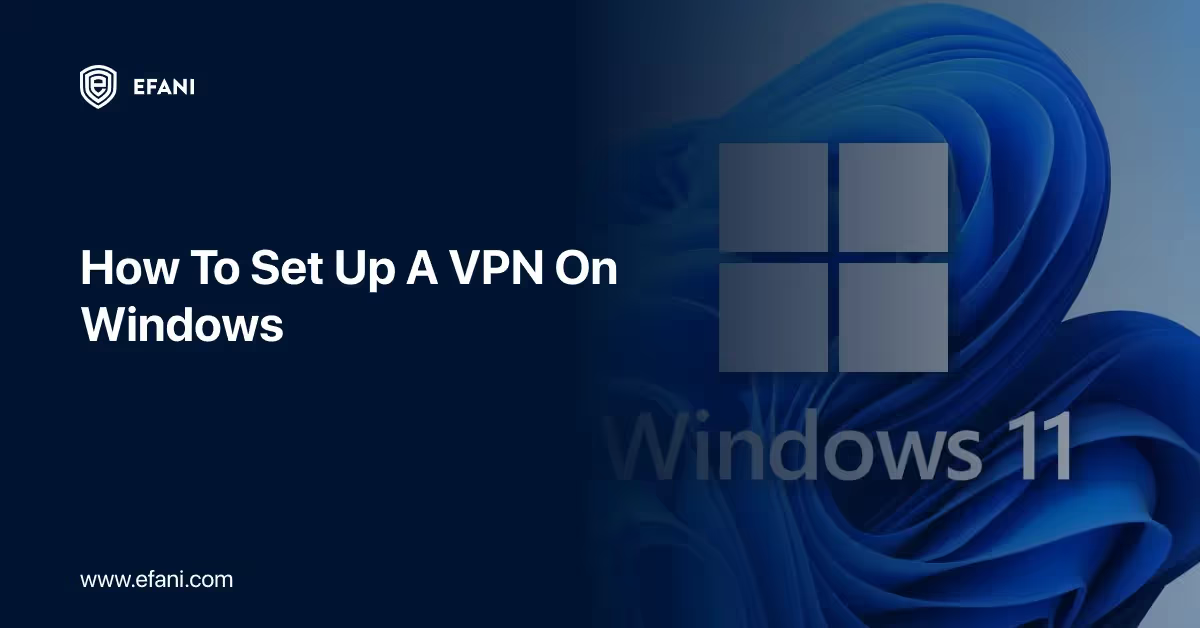How to Set Up A VPN on Windows


Introduction
Imagine the Internet as a giant open road. It's a fantastic way to explore new information and connect with people worldwide. But, like on a real road trip, you might sometimes want extra privacy and security. That's where a VPN comes in! A VPN is a unique, encrypted tunnel on the Internet highway. It hides your online travels from prying eyes and keeps your information safe.
Is your cellphone vulnerable to SIM Swap? Get a FREE scan now!
Please ensure your number is in the correct format.
Valid for US numbers only!
Why Use a VPN on Windows?
Following are the benefits of using VPN on Windows:
- Privacy Matters: A VPN helps keep your online activity private. It hides things like your browsing history, downloads, and even your location from anyone watching on the internet highway. It is essential when using public Wi-Fi networks at cafes, airports, or hotels.
- Security Boost: A VPN encrypts your internet traffic, making it like a secret code that only you and the VPN server can understand. It strengthens the security of your online activity and makes it more difficult for hackers to acquire your data.
- Unlocking the World: Some websites and online services might be restricted depending on location. Websites can appear as though you are surfing from a different country by using a VPN to connect to a server there. It allows you to access content that might be blocked in your area.
Choosing the Right VPN for Your Windows PC:
Picking a good VPN is like choosing the perfect travel companion for your online adventures. Here are some things to consider:
- Price: VPN services come in different price ranges. There are free options, but they might limit features or speed. Paid VPNs typically offer better security, speed, and customer support.
- Features: Look for a VPN that offers the features you need, such as solid encryption, various server locations, and easy-to-use software for Windows.
- Reputation: Choose a VPN provider with a good security and customer service reputation. Before choosing, check out reviews on the Internet and evaluate several choices.
Here are some popular VPN providers for Windows:
- ExpressVPN
- NordVPN
- CyberGhost
- Private Internet Access
Setting Up Your VPN on Windows:
Once you've chosen a VPN provider, it's time to set up your connection on your Windows computer. It's usually a simple process:
- Download the VPN Software: Visit your chosen VPN provider's website and download the Windows client software. It is like downloading a new game or app for your Windows PC.
- Installation Steps: Double-click the downloaded file and follow the on-screen instructions. You might need to enter your administrator password to complete the installation.
- Create an Account (if required): Many VPN companies require you to create an account and provide your subscription details. It is comparable to obtaining a VPN tunnel travel pass.
SIM Swap Protection
Get our SAFE plan for guaranteed SIM swap protection.
Configuring Your VPN Settings:
Now that the software is installed, it's time to configure your VPN connection:
- Open the VPN software you downloaded earlier. It might appear in your Start menu or the taskbar at the bottom of your Windows screen.
- Select the server location you want to connect to. Remember, this makes it seem like you're browsing the Internet from that location. Most VPN providers offer servers in many different countries.
- VPN protocols are like different security languages used by the tunnel. Some standard options are PPTP, L2TP/IPsec, and OpenVPN. The best option may vary depending on your needs and the VPN provider. Don't worry; most VPN software offers recommendations or automatic settings for this.
Monthly
Yearly
Testing Your VPN Connection:
Before you set off on your online adventures with your VPN, it's a good idea to test your connection:
- Leak Check: Use a website or tool offered by your VPN provider to check for leaks. Leaks are like tiny holes in the tunnel that could reveal your location.
- Verify Connection: Visit a website that shows your IP address. If the VPN works correctly, the website should show the IP address of the server you connected to, not your actual location.
Troubleshooting Common Issues:
Sometimes, even the best travel plans can hit a bump. Here's how to deal with common VPN issues on Windows:
- Connection Problems: If you can't connect to the VPN, try restarting your computer and the VPN software. You can also try connecting to a different server location.
- Speed Issues: A VPN can sometimes slow down your internet connection. If this happens, try connecting to a server closer to your location. You can also adjust settings within the VPN software to optimize speed.
- Contact Support: If you're still having trouble, most VPN providers offer customer support through live chat, email, or phone. Don't hesitate to reach out for assistance.
Conclusion:
You've successfully set up a VPN on your Windows computer. You are now equipped to travel the web with more privacy and security. Remember, using a VPN is like taking an extra step towards online safety. Here's a quick recap:
- Download the VPN client software for Windows from your chosen provider.
- After installing the software, adhere to the on-screen directions.
- Create an account with your VPN provider (if required).
- Configure your VPN settings, including server location and protocol.
- Connecting to the VPN server offers a more secure and private internet experience.
- Test your VPN connection to ensure it's working correctly.
Following these steps and keeping your VPN software and Windows up-to-date can significantly enhance online privacy and security. Remember, the Internet is a vast and wonderful place, but just like travelling in the real world, it's essential to be prepared and take precautions to stay safe. With a VPN as your travel companion, you can confidently explore the online world, knowing your information and activities are protected.







